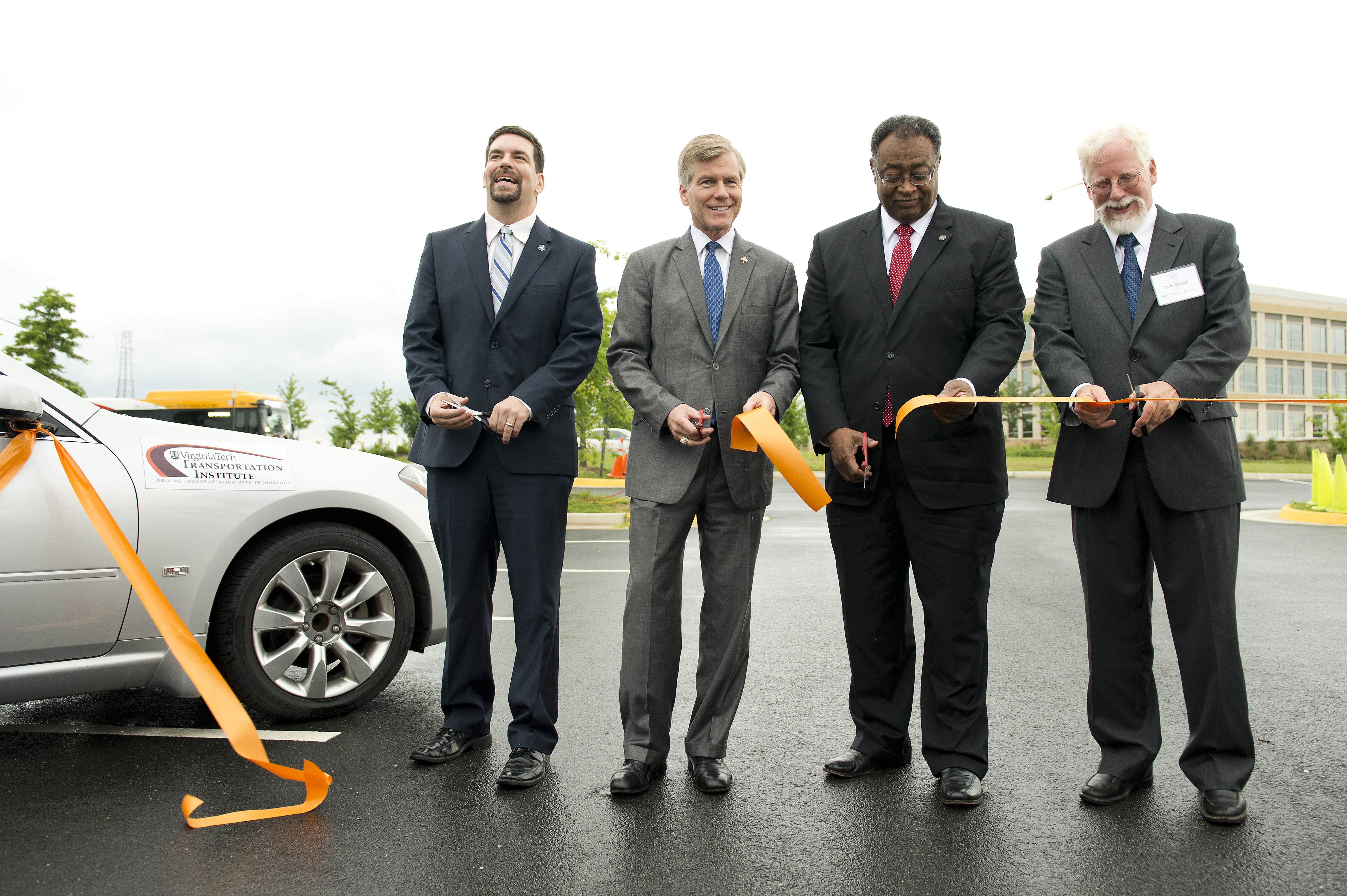Gov. Bob McDonnell helps Virginia Tech Transportation Institute launch Virginia connected vehicle test bed

On June 6, Virginia Gov. Robert McDonnell attended the official launch of the Virginia Connected Test Bed, a public-private partnership spearheaded by the Virginia Tech Transportation Institute. The initiative involves vehicles equipped with connected wireless technology that enables them to “talk” to each other via wireless sensors installed along the highway infrastructure.
The idea of allowing communication between cars, motorcycles, trucks, and wireless infrastructure along the roadway revolves around the goals of saving lives; preventing crashes, traffic congestion and bottlenecks; and improving the sustainability of roadways while reducing environmentally harmful exhaust and wasted gasoline caused by traffic congestion.
Now in the early test stage, the $14 million project involves a total of 43 “connected” intersections in Merrifield, Va., near Fairfax, along the Interstate 66 corridor and state Highways 29 and 50. Wireless infrastructure devices were installed near the road to track and receive information from with test-cars equipped with their own installed wireless communication technology.
A second, smaller test-bed is located at the closed-course Smart Road in Blacksburg, Va., at the headquarters of the Virginia Tech Transportation Institute.
“This test bed will allow Virginia researchers to develop a range of applications that will result in faster infrastructure repair and maintenance, better emergency-response times and incident and congestion management,” McDonnell said at the event.
The governor was joined by Virginia Commissioner of Transportation Gregory Whirley, and Catherine McGhee, associate director for safety, operations. and traffic engineering for the Virginia Center for Transportation Innovation and Research, the research division of the Virginia Department of Transportation. Other speakers were Virginia Tech Transportation Institute Director Thomas Dingus and David Friedman, the deputy administrator of the National Highway Traffic Safety Administration.
“Most importantly, this research seeks to save drivers in Virginia both time and money by offering technological solutions for a safer driving experience and improved travel times on those unavoidable workday commutes,” McDonnell added. “I applaud this creative partnership between two of our excellent universities and the public sector. It goes to show that by working together and harnessing emerging technology we can improve the lives of Virginians.”
The governor added that new technology, such as the wireless communication devices along the test-bed corridor, could do as much to help alleviate congestion as the building or widening of new highways. Whirley said the test-bed is comprised of “research that saves lives.”
The test-bed project is operated by a public-private consortium known as the Connected Vehicle-Infrastructure University Transportation Center, or CVI-UTC. Dingus is director of the center as part of the work of the Virginia Tech-led initiative. The partnership includes the University of Virginia’s Center for Transportation Studies, Morgan State University in Maryland, and the Virginia Center for Transportation Innovation.
The overall project, including contribution underwriting for the development and installation of the test bed, is funded through a four-year, $6 million federal grant by the U.S. Department of Transportation; a $4 million cost share from the state Department of Transportation, and $2 million from the Virginia Tech institute, with additional funding coming from the other partners.
Dingus spoke of future impact of the research project, and how it can save lives in years to come.
“The goal is to test a device that will alert workers of accidental close interactions with vehicles. Another example is the development of a communication system designed to decrease the number of crashes with school buses,” Dingus said. “The system could be used to provide drivers traveling behind buses with in-vehicle notifications of a stopped bus.”
Dingus explained vehicles are alerted if they are at risk of a crash and critical roadside information is communicated directly for the driver to see on the dashboard. He said the technology can also communicate car and road information to the communications infrastructure so that alerts can be sent to other drivers. For instance, detection of slick pavement or the presence of roadway debris could be gathered from one vehicle, sent to the roadside detector, and then quickly disseminated to other vehicles on the system.
The outdoor ribbon-cutting event for the test bed took place at the McConnell Public Safety and Transportation Operations Center in Fairfax, a county/state communications center that houses 911 and 511 call centers, among other agencies and groups.
The previous day, June 5, institute researchers demonstrated the test bed to more than 100 guests, many from the transportation industry and related government agencies. Participants rode inside a bus along I-66 and saw alerts on large screens ping when their vehicle drew close to another test vehicle, and also witnessed warning displays of demonstrated near-collisions at the McConnell parking lot in Fairfax.
The Virginia Connected Vehicle Test Bed includes a total of 43 intersections in and around Merrifield, Va., that are equipped with wireless infrastructure units.
The consortium uses two mobile wireless units to collect data beyond the current scope of the stationary intersections.
Twelve research vehicles collect information such as acceleration, braking, curve handling, and emissions, and four of these 12 are the only connected motorcycle fleet in existence.
The connected vehicle test fleet also includes two large vehicles: a bus and a semi-truck to test public transportation and freight applications.




